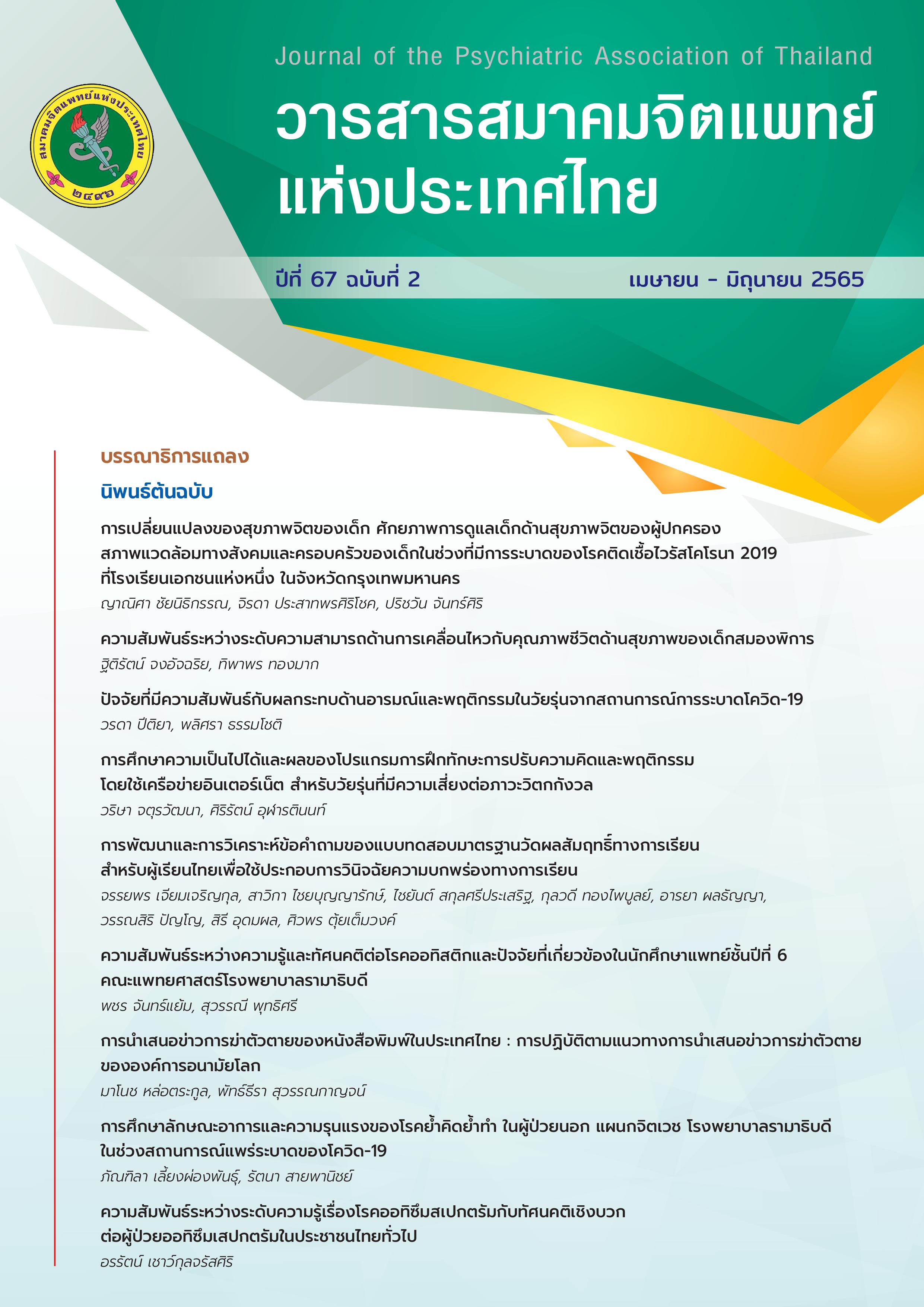A study of clinical symptoms and severity of obsessive-compulsive disorder Patients at Ramathibodi Hospital during the COVID-19 pandemic
Main Article Content
Abstract
Objective : To examine clinical characteristics and severity of obsessive-compulsive disorder (OCD) in psychiatric out-patient unit at Ramathibodi hospital during COVID-19 pandemic.
Methods : Descriptive cross-sectional study was conducted. Participants were OCD patients aged 18 years old or older and visited the psychiatric out-patient unit of Ramathibodi hospital between May 2020 and May 2021. Instrument was used the Yale Brown Obsessive Compulsive Scale II to assess characteristics and severity of obsessive-compulsive disorder.
Results : Participants were 126 OCD patients. The most common obsessive symptom was contamination and most common group of obsession were contamination. The most common compulsive symptom was checking locks, stoves and electrical appliances and most common group of compulsion were checking. Severity of obsessive-compulsive symptom was moderate.
Conclusions : The most common obsession was contamination. The most common compulsion was checking. These results may be associated with COVID-19 pandemic. Further studies are needed.
Article Details

This work is licensed under a Creative Commons Attribution-NonCommercial-NoDerivatives 4.0 International License.
Articles submitted for consideration must not have been previously published or accepted for publication in any other journal, and must not be under review by any other journal.
References
American Psychiatric Association. Diagnosis and statistic manual of mental disorder. 5 ed. Washington DC: Arlington VA: American
Psychiatric Association 2013.
Mataix-Cols D, Marks IM, Greist JH, Kobak KA, Baer L. Obsessive-compulsive symptom dimensions as predictors of compliance with and response to behaviour therapy: results from a controlled trial. Psychother Psychosom 2002;71(5):255-62.
Bloch MH, Landeros-Weisenberger A, Rosario MC, Pittenger C, Leckman JF. Meta-analysis of the symptom structure of obsessive-compulsive disorder. Am J Psychiatry 2008;165(12):1532-42.
Mataix-Cols D, do Rosario-Campos MC, Leckman JF. A multidimensional model of obsessive-compulsive disorder. Am J Psychiatry 2005;162(2):228-38.
Carmi L, Ben-Arush O, Fostick L, Cohen H, Zohar J. Obsessive compulsive disorder during Coronavirus disease 2019 (COVID-19): 2-and 6-month follow-ups in a clinical trial. Int J Neuropsychopharmacol 2021;24(9):703-9.
Chakraborty A, Karmakar S. Impact of COVID-19 on obsessive compulsive disorder (OCD). Iran J Psychiatry 2020;15(3):256.
Jelinek L, Moritz S, Miegel F, Voderholzer U. Obsessivecompulsive disorder during COVID-19: turning a problem into an opportunity. J Anxiety Disord 2021;77:102329.
Rufer M, Fricke S, Moritz S, Kloss M, Hand I. Symptom dimensions in obsessive–compulsive disorder: prediction of cognitive-behavior therapy outcome. Acta Psychiatrica Scandinavica 2006;113(5):440-6.
Landeros-Weisenberger A, Bloch MH, Kelmendi B, Wegner R, Nudel J, Dombrowski P, et al. Dimensional predictors of response to SRI pharmacotherapy in obsessive–compulsive disorder. J Affect Disord 2010;121(1-2):175-9.
Takurngsakdakul A, Hiranyatheb T, Saipanish R. Clinical characteristics and severity of obsessive-compulsive disorder in a psychiatric out-patient unit at Ramathibodi hospital. J Psychiatr Assoc Thailand 2012;57(4):463-76.
Matsunaga H, Maebayashi K, Hayashida K, Okino K, Matsui T, Iketani T, et al. Symptom structure in Japanese patients with obsessive-compulsive disorder. Am J Psychiatry 2008;165(2):251-3.
Tripathi A, Avasthi A, Grover S, Sharma E, Lakdawala BM, Thirunavukarasu M, et al. Gender differences in obsessivecompulsive disorder: findings from a multicentric study from India. Asian J Psychiatr 2018;37:3-9.
Chowdhury M, Rahman H, Mullick MS, Arafat S. Clinical profile and comorbidity of obsessive-compulsive disorder among children and adolescents: a cross-sectional observation in Bangladesh. Psychiatry J 2016;2016:9029630
Hiranyatheb T, Saipanish R, Lotrakul M. Reliability and validity of the Thai version of the Yale–Brown obsessive compulsive scale–second edition in clinical samples. Neuropsychiatr Dis Treat 2014;10:471.
Goodman WK, Price LH, Rasmussen SA, Mazure C, Fleischmann RL, Hill CL, et al. The Yale-Brown obsessive compulsive scale: I. development, use, and reliability. Arch Gen Psychiatry 1989;46(11):1006-11.
Hiranyatheb T, Saipanish R, Lotrakul M, Prasertchai R, Ketkaew W, Jullagate S, et al. reliability and validity of the Thai self-report
version of the Yale–Brown obsessive–compulsive scale. Neuropsychiatr Dis Treat 2015;11:2817.
Sobin C, Blundell M, Weiller F, Gavigan C, Haiman C, Karayiorgou M. Phenotypic characteristics of obsessive–compulsive disorder ascertained in adulthood. J Psychiatr Res 1999;33(3):265-73.
Torresan RC, de Abreu Ramos-Cerqueira AT, de Mathis MA, Diniz JB, Ferrão YA, Miguel EC, et al. Sex differences in the phenotypic expression of obsessive-compulsive disorder: an exploratory study from Brazil. Compr Psychiat 2009;50(1):63-9.
Labad J, Menchon JM, Alonso P, Segalas C, Jimenez S, Jaurrieta N, et al. Gender differences in obsessive–compulsive symptom
dimensions. Depress Anxiety 2008;25(10):832-8.
Khandelwal A, Aggarwal A, Garg A, Jiloha R. Gender differences in phenomenology of patients with obsessive compulsive disorder. Delhi Psychiatry Journal 2009;12(1):8-17.
Williams MT, Mugno B, Franklin M, Faber S. Symptom dimensions in obsessive-compulsive disorder: phenomenology and treatment outcomes with exposure and ritual prevention. Psychopathology 2013;46(6):365-76.
Storch EA, De Nadai AS, Do Rosário MC, Shavitt RG, Torres AR, Ferrão YA, et al. Defining clinical severity in adults with obsessive–compulsive disorder. Compr Psychiatry 2015;63:30-5.


